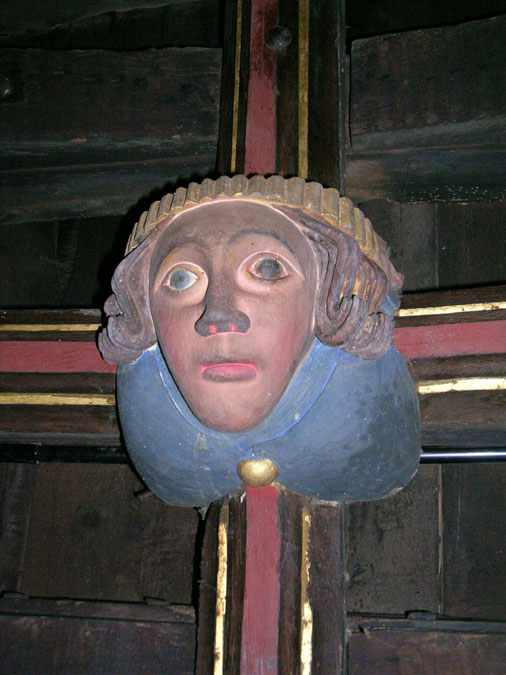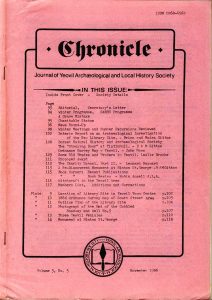This article came from the Chronicle published November 1986. Pages 96-98.
News Round-Up
ABERYSTWYTH. An extremely important discovery has been made by archaeologists working in conjunction with British Gas, who have been laying a pipe-line from Machynlleth to Aberystwyth. They have found evidence of a settlementon land owned by the Welsh Plant Breeding Station near Aberystwyth which could be one of the earliest Christian sites in Wales, if not in the British Isles. Thirteen Christian burials and three oratories or chapels have been found. [The arrangement of a number of small chapels instead of a single church echoes important early Christian sites in Ireland, such as those at Clonmacnois, Co.Offaly and Kilmacduagh, Co.Clare, but is virtually unknown on mainland Britain. – Ed.]
BOVEY TRACEY, DEVON. A valuable early Saxon brooch has been discovered by Mr.Frank Bord, a former detective, in a cremation barrow during excavations near his home.
GREAT WISHFORD, WILTS. The missing nose from the 14th century military effigy, attributed to Sir Nicholas de Bonham, in Great Wishford parish church, has been restored in an unusual and irregular manner. A plastic surgeon from Odstock Hospital, near Salisbury, has fashioned a new nose from wax, dental bonding material and glue.
ILCHESTER. In contrast to the extensive work carried out in Ilchester in 1986, a very short excavation has been carried out in recent weeks. It was in a small, isolated plot of land between Church Street and High Street, in the general area of the Dolphin Inn. Two trenches were opened up, revealing features from a number of different periods.
LONDON, ROMAN BASILICA. This important excavation off Leadenhall St. was concluded at the end of September 1986 see Chronicle Vol. 3 p.85. Massive foundations of the Basilica have been found, in keeping with its reputation as the largest Roman civic building north of the Alps. It had been preceded by more humble timber buildings during the 1st century A.D. and in the mediaeval period it was superseded by one of London’s most famous pre-Reformation buildings – the Leaden Hall. It was due to the Basilica’s continued use as the foundations of the mediaeval hall that the Roman walling survived to a height of about 9 feet. The developer of the site, Legal and General, have sponsored the excavation but do not plan to preserve the remains as had been the case when they developed another piece of land in the 1960’s and discovered the Temple of Mithras.
LONDON, ROYAL MINT. Excavations have been taking place since June on the site of the former Royal Mint (London EC3). The purpose is to uncover the remains of the Cistercian Abbey of St.Mary Graces, which was founded by Edward III in 1350 and became one of the richest and most powerful Cistercian houses in Britain. The land is owned by the Crown Estate Commissioners who are funding the excavation. The re-development plan will include a museum to incorporate any remaining structure of the Abbey into the basement of the new building.
MAIDEN CASTLE, DORSET. Four months of excavation by the Trust for Wessex Archaeology on behalf of English Heritage have revealed information about this nationally important monument. The work has been carried out in two areas, one in the south-west corner of the main enclosure and the other at the eastern entrance. The former location covers the larger area and has yielded the greater amount of evidence including three circular wooden buildings and a sloping approach to the adjacent ramparts. Some sixteen deep grain storage pits have been revealed, hewn out of the chalk. One of the buildings had a number of hearths, suggesting a centralised cooking facility and part of a stone wall was evident where the new excavations met those carried out by Sir Mortimer Wheeler about 50 years ago. The East Gate site is outside the main enclosure and it is probably significant that a great deal of burnt material, suggestive of iron smelting has been found there, well away from the combustible structures within the fort. More to be expected at this battle site was a neat pile of sling shot.
Two aspects of the dig have been given special emphasis. Firstly, there has been a thorough collection of environmentally significant material such as seeds and pollen, which will be analysed in detail, together with the tens of thousands of animal bones also recovered. Secondly, the whole monument and the immediately surrounding countryside are being surveyed, to set Maiden Castle in its historical geographical context. The project has been controversial, because of its high cost (about £400,000) when more pressing cases could be made for rescue excavations to be carried out on sites which, unlike Maiden Castle, are seriously threatened.
Daily Telegraph: 3.9.86
Western Gazette: 12.9.86
Popular Archaeology: Aug. ’86
YEOVIL: 56 and 58 MIDDLE STREET. In June 1986, when the archaeological investigation of the new Library site was at its height see report on p. 102 of this issue a second opportunity arose to discover more of Yeovil’s past. A re-development of numbers 56 and 58 Middle Street (No.56 was previously occupied by Foster Menswear involved the demolition of the old shops and deep digging to secure the new foundation. Three visits were made, the first being in the company of Mr.Dennison of the County Archaeologist’s Department. The evidence was most unexpected. The clean, sandy soil was almost totally devoid of features or artifacts even though the total depth of digging extended to more than 20 feet below the present road level., in the case of a small, cellar on the western side of the plot. This negative evidence must be regarded as significant. It could mean that the present course of Middle Street is greatly different from that in the mediaeval town or that the course of Pyt Lane did follow that of Middle Street but without any mediaeval buildings in the region of Nos.56 and 58. It is quite feasible that the area was farm or open land throughout the mediaeval period, so that the buildings which have just been demolished were the only ones to occupy the site.
YEOVIL: ST.JOHN’S. There has been concern about the integrity of the floor of the west end of the south aisle, on which the font stands. Floorboards were therefore taken up, revealing the top surface of a tunnelled vault, lying east-west in the middle of the aisle. It was also apparent that a number of the floor joists are re-used timbers.

